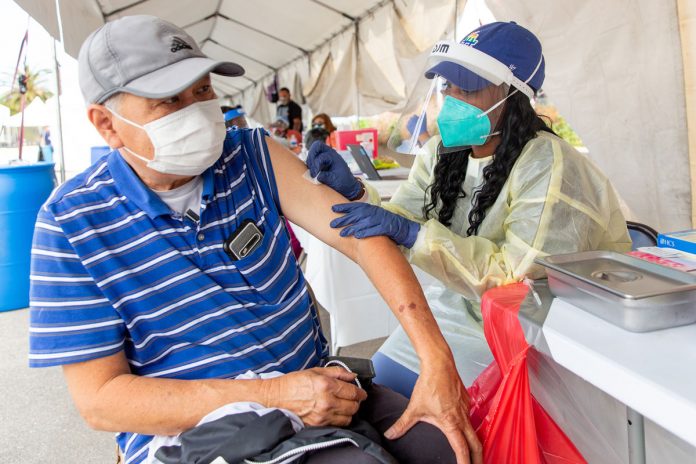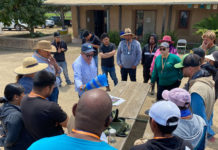
For the first time, more than 3 million people, on average, are receiving a COVID-19 vaccine each day in the United States, according to data from the Centers for Disease Control and Prevention. And Saturday the country reported over 4 million doses in a single day for the first time.
The milestones reflect a steady increase in the capacity of states to deliver shots into arms. In early March, the nation surpassed an average of 2 million doses administered each day. The average hovered at around 800,000 doses a day in mid-January. And nearly one-third of the U.S. population has received at least one dose of a COVID-19 vaccine as more states expand eligibility and production ramps up.
The news, which comes as President Joe Biden enters the homestretch of his first 100 days in office and amid the general declines in new virus cases, deaths and hospitalizations since January, offers a sign of hope for a weary nation. But the average number of new reported cases has risen 19% over the past two weeks, and federal health officials say that complacency about the coronavirus could bring on another severe wave of infections.
“We have so much to look forward to, so much promise and potential of where we are, and so much reason for hope,” Dr. Rochelle Walensky, director of the CDC, said in an emotional plea to Americans this week. “But right now I’m scared.”
The rising vaccination rate has prompted some state officials to accelerate their rollout schedules. This past week, Gov. Ned Lamont of Connecticut expanded access to people 16 and older, several days ahead of schedule. And Gov. Jared Polis of Colorado opened universal eligibility about two weeks earlier than planned.
“No more having to sort out if you’re in or if you’re out,” said Julie Willems Van Dijk, the deputy secretary of the Department of Health Services in Wisconsin, where anyone 16 or older will be eligible for a vaccine as of Monday. “It’s time to just move forward and get everybody with a shot in their arm.”
In another promising development, federal health officials said Friday that Americans who are fully vaccinated against the coronavirus can travel “at low risk to themselves” within the United States and abroad.
But these days, most signs of hope are offset by peril.
Over the past week, there has been an average of 64,730 cases per day, an increase of 19% from two weeks earlier, according to a New York Times database. New deaths on average have declined, but they are still hovering around 900 a day. More than 960 were reported Friday.
The CDC predicted this past week that the number of new COVID-19 cases per week in the United States would “remain stable or have an uncertain trend” over the next four weeks, and that weekly case numbers could be as high as about 700,000 even in late April.
Cases are already increasing significantly in many states, particularly in the Midwest and Northeast, as variants spread and some governors relax mask mandates and other restrictions. Walensky said this past week that if states and cities continued to loosen public health restrictions, the nation could face a potential fourth wave.
Michigan, one of the worst-hit states, is reporting nearly 6,000 cases a day — up from about 1,000 a day in late February — even though half of its residents over 65 are now fully vaccinated.
And in Ohio, Gov. Mike DeWine said that new variants were aggravating the state’s caseload, even as vaccinations picked up.
“We have to understand that we are in a battle,” he said.
As if to underscore how fragile the nation’s recovery is, a quintessential American ritual — the start of the baseball season — has already faced a virus-related delay.
Major League Baseball officials said Friday that the league had found only five positive cases in more than 14,000 tests of league personnel. But because four of those people were Washington Nationals players, the team’s opening day game against the New York Mets was postponed, and then the team’s three-game weekend series.
“It’s one of those things that brings it to light that we’re not through it yet,” Brian Snitker, the Atlanta Braves manager, told The Associated Press. “We’re still fighting this.”
Copyright 2021 The New York Times Company














